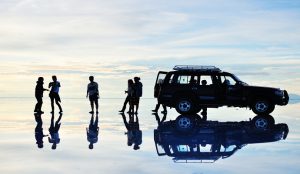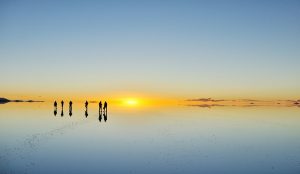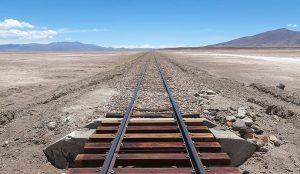 Print Itinerary
Print Itinerary
Inclusions:
- All Accommodation and Transfers
- Daily Breakfast
- All Meals while in Uyuni Salt Flats
- Activities as per itinerary
Daily departures available
Day 1 LA PAZ
Our guide and transport will be waiting for you at the airport (or bus station) and transfer you to the hotel of your selection. Short briefing about the activities for the next day.
Day 2 LA PAZ (B)
Half day city tour in La Paz where we will be visiting the famous Mercado de Brujos (Witches’ Market) and San Francisco Church. Then we continue to the Murillo Main Square, where the Cathedral, Government Palace and the National Congress are located. After this, we will be visiting the colonial street of Jaen, where several museums are located. The tour will continue through the well-known residential areas of La Paz such as Obrajes, Calacoto and La Florida finally arriving at the great and imposing Moon Valley where we do a light hike among the impressive natural sand towers. Return to the hotel.
Day 3 LA PAZ – UYUNI – MALLKU (L-D)
Morning transfer to the airport of La Paz and flight to the city of Uyuni. Reception at the airport and our guide and transport will be ready to take you for our overland adventure in the area of the Abaroa National Park and the Uyuni Salt Desert. From Uyuni we drive south, towards the town of Mallku. Our first visit will be to the Train Cemetery where you can see the remains of 19th and early 20th century steam locomotives. Then we continue our drive southwards to the historical town of San Cristobal, a place well known for its silver mining activities, still currently running. Then we continue our drive through the high Andean plateaus. On the way with some luck, perhaps we will be able to see the Andean Ostrich (locally known as Suri or ñandu). Later on, we will stop for a visit at the place known as the Ciudad de Piedra (Stone City), an interesting geological formation. Finally, we will arrive in the small town of Mallku where we will overnight in a small local hotel. Here we can take a short walk to visit the rock and cave paintings.
Day 4 MALLKU – LAGUNA COLORADA (B – L – D)
Today we drive southwest, towards the Eduardo Abaroa National Park. Our drive will take us through the small indigenous villages of Quetena Chico and Quetena Grande, from where we have clear views of the Uturunco Volcano. We continue our drive to the shores of the beautiful Laguna Colorada. This lagoon lies at an altitude of 4,278 metres and covers an area of 60 km2. The rich red colouration derives from algae and plankton, which thrives in its mineral-filled water and the shoreline fringes with brilliant white deposits of sodium, magnesium, borax and gypsum. Numerous flamingos, three species of which breed here, inhabit the lagoon. Then we continue our drive south to the place known as “Sol de Mañana” where at 4,850 metres lies a geyser basin with bubbling mud pots, hellish fumaroles and a thick aroma of sulphur fumes. This is a site of intense volcanic activity. Then we cross through the Dali Valley, a desert covered with strange stone formations, on our way to the base of the high steep Licancahur Volcano where we find the Laguna Verde and Laguna Colorada. Return to Laguna Colorada for overnight in a basic refuge.
Day 5 LAGUNA COLORADA – SAN JUAN (B – L – D)
Early in the morning, we start our drive north towards the small town of San Pedro de Quemez. Our first stop will be at the Arbol de Piedra (Tree of Stone), located in the Siloli desert. Later on we will pass the lagoons known as Ramadita, Honda, Chiarjota, Hedionda and Cañapa. In all these lagoons, we will find flamingos and other interesting Andean birds and with some luck, perhaps we can observe the flight of the Condor. Later on we will see the active Ollague Volcano (5,865m) and then we will cross the Salar de Chiguana before we arrive at the town of San Juan for overnight in a small local hotel. (Program for those passengers choosing the Tayka Hotel: Crossing the Salar de Chiguana towards the historical remains of Pueblo Refugio, a place where the inhabitants of San Pedro de Quemez hid when the Chilean army invaded Bolivia. Finally we will arrive in the town of San Pedro de Quemez for overnight in Tayka Hotel de Piedra.
Day 6 SAN PEDRO DE QUEMEZ – SALAR DE UYUNI – UYUNI (B – L)
In the morning we start our drive towards the world famous Salar de Uyuni. Our first visit will be at the Galaxy cave, a dried sub-aqueous cavern. Then we continue our drive towards Isla Pescado (Fish Island), a hilly outpost covered with trichocerus cacti and a flat, white sea of hexagonal salt tiles. A large population of stranded viscachas (Andean rodents) inhabits its rocky slopes. From here, we continue towards the Incahuasi Island, another interesting hilly island situated in the center of the Salar with a rock formation that contains the remains of corals and seashells. Here we hike up to the summit of the hill, from where we get an extraordinary view of the surreal Salar de Uyuni. After lunch, we will continue our drive towards the small village of Colchani, which lies besides the Salar de Uyuni and gives home to the Cooperative Rosario – the main plant for the iodisation of salt. After visiting the artisanal salt factory, we will make our final drive to Uyuni where we arrive late in the afternoon.
Day 7 UYUNI – POTOSI (B)
Morning transfer from Uyuni to the city of Potosi. This overland trip has plenty of wonderful views of the highlands in this area. Up on arrival in Potosi, we check in the hotel and in the afternoon, we make a city tour visiting the colonial part of this interesting city, including a visit to La Casa de La Moneda and the museum. Hotel.
Day 8 POTOSI – SUCRE (B)
Morning tour to the famous mines of Cerro Rico. Borrowing down into its bowels you can experience what life was like many centuries ago for those working in these mines. In the afternoon, travel to Sucre, the Capital of Bolivia. Hotel accommodation.
Day 9 SUCRE (B)
In the morning, we take a half day city tour of Sucre, declared as World Heritage Site by UNESCO. This beautiful colonial city preserved from modernity, shows interesting places to visit and enjoy the main plaza, Bolivar Park, several convents dating from the XVI century, etc. Back to the hotel. Free afternoon.
Day 10 SUCRE – LA PAZ (B)
In the morning transfer to the airport for your flight to the city of La Paz. Transfer to the hotel and free time.
Day 11 LA PAZ (B)
In the morning transfer to the airport for your flight back home.
End of our services
Food Code = (B) – Breakfast, (L) – Lunch, (D) – Dinner.
LHEABOL002 *Please note, prices based on twin share, per person, 3 star rates. Tour based on a minimum of two participants and private. The itinerary & pricing can change at any time due to availability & of activities. Please check our website for full terms and conditions*
More Information on Bolivia:
Bolivia – officially known as the Plurinational State of Bolivia it is a landlocked country located in central South America. It is bordered by Brazil to the north and east, Paraguay and Argentina to the south, Chile to the southwest, and Peru to the west. Prior to European colonization, the Andean region of Bolivia was part of the Inca Empire – the largest state in Pre-Columbia America.
More information on the visited places:
La Paz – a city for both enriching visits and adventurous discoveries. Lose yourself in streets brimming with life, where neighbours, artisans and sorcerers rub elbows amidst the daily bustle of typical markets. La Paz’s outskirts also offer an array of spectacular sites, such as eerie rock sculptures created from ancient erosion at the Valley of the Moon.
Uyuni Salt Flats – four-wheel-drive expedition across the breathtaking landscapes of salt pans at Salar de Uyuni and the multicolored deserts of the Sud Lípez region, in the remote southern Bolivian Andes.
Laguna Colorada – the gems of South America’s Central Andes offers stunning scenery and world-class, off-road adventure filled with the daily drama of wildlife in some of the most hidden corners of our world.
Potosi – the department of Potosi boasts two of Bolivia’s most famous attractions, Uyuni Salar, the world’s largest salt flat, and the Siloli Desert. Its capital is the city of Potosi, whose history of Potosi has been dominated by the legendary Mount Potosi, at whose foothills it lies. More popularly known as Cerro Rico, or Rich Mountain, it has been the largest and most prosperous silver mine in the history of the world. According to oral tradition, the name Potosi itself is rooted in the onomatopoeic Quechua word potq, which reproduces the sound of a hammer striking ore.
The narrow streets of Potosi are lined with a wealth of baroque churches (as many as one every couple of blocks) and stylish colonial mansions. These, among them architectural wonders such as the gothic Potosi Cathedral, and the 18th century Torre de la Compania convent date back to the city’s legendary heyday and reflect the splendour of that period. Arguably one of the most important colonial buildings is the Casa Nacional de Moneda which was once the royal mint and now houses one of South America’s best museums, boasting an expansive religious and contemporary art collection and artifacts from its colonial history. The architectural and historical wealth is also the main reason that in 1987 Potosi became the first place in Bolivia to be declared a UNESCO World Heritage Site.
Visa Requirements for Bolivia*:
Visa is not required for Australian Citizens for a stay of maximum 30 days.
For more information contact your nearest Bolivian Embassy or Consulate




